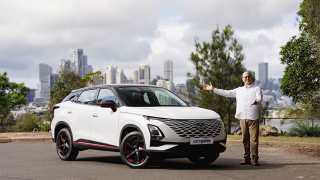
How to find the perfect wheels and tyres for your car

Adding a shiny new set of rims to your dual-cab is a great way of making your car stand out from the crowd… but it could also get very ugly if you ignore the basics when it comes to fitting aftermarket wheels. Let’s have a closer look at the dos and don’ts of adding aftermarket wheels and tyres to your adventure vehicle.
Up or down

When it comes to adding new wheels, you can go one of three ways when it comes to the diameter of the rims; stay the same, go bigger, or go smaller.
Generally speaking, larger rim sizes are for show, while smaller are for go. To expand on that a little, a larger wheel – take, for example, a 20-inch diameter rim – may look stunning on the car, but in actual fact it generally creates more issues than it solves. Compared to an 18-inch rim, which is standard on many high-end 4x4 dual-cabs like the Toyota HiLux SR5 and Ford Ranger Wildtrak, a 20-inch rim is demonstrably heavier, sometimes by two or three kilograms per wheel.
An aftermarket rim has to match the stock wheel’s load rating (usually etched inside the rim), as well; this is not only a safety consideration, but your insurer will leave you high and dry if a rim failure leads to other damage – or worse.
matching the required load rating is just as important.
Legally speaking, most states and territories will accept an increase in overall diameter of the new wheel/tyre combo of between 15mm and 25mm over the stock combo, and a width increase of 15mm. This varies between states, though, so it’s in your best interest to check.
This will apply to your insurer, too – most will accept a ‘plus one’ or ‘plus two’ (18-inch to 19- or 20-inch, for example) upgrade, as long as they are told about it.
As well, the tyres needed to fit the larger rim will be almost certainly be only suitable for on-road duty, thereby taking away a big part of your car’s ability.
It’s possible to overcome these inherent downsides by throwing considerable sums of money at the problem, and a reputable wheel and tyre retailer can assist in finding you a boss set of rims and tyres that are also safe and insurable... but be ready for a serious price-tag.
Going the other way – downsizing – has less peril, though matching the required load rating is just as important.
A smaller diameter wheel allows the fitment of a tyre with a taller sidewall, which in an off-road situation gives you the ability to find more grip by lowering the tyre’s pressure and increasing its footprint on the ground.
“Off-roaders in vehicles like the Ranger and Nissan Navara will downsize to a 16-inch steel wheel, or a 17-inch alloy shod in a 285/70 R17 sized tyre – also known as a 33-inch tyre - while owners of HiLuxes, VW Amaroks and Holden’s Colorado tend to go for 265/70 R17s, or 32s,” says Jarrard Barr, owner of Melbourne metro tyre and wheel store The Wheel Deal. “33s are our bread and butter for the off-road guys.”
Wheel styles and materials

When it comes to wheel materials, there are two main types to consider: steel or aluminium.
A steel rim has the advantage of being tougher than old boot leather, and is ideally suited to life in the rough stuff. If you dent it, for example, it can be hammered straight. It is heavier than an aluminium wheel, though.
The only type of alloy to consider is a forged type, where the wheel is milled into a shape, then heat-treated for strength. An alloy wheel is lighter, but if it’s damaged badly enough in an impact, it can break. However, high-quality forged alloy rims can cop an amazing amount of abuse, and can even be repaired back in civilisation should they suffer a flat spot out in the bush.
with deep grooves and large tread blocks that are designed to dig down and grab all the grip it possibly can.
A warning: a cheap alloy rim will not bend. It will break, and usually in a catastrophic way. And usually when you are a long drive from civilisation, too.
High-end off-road rims can also be built from both materials in a two- or three-piece composite style. These are generally reserved for off-road racing use, but their modular construction means that they can be repaired easily.
When it comes to off-road tyres for 4x4 dual cabs, the two predominant styles of tyre are known generically as all terrain tyres or mud tyres.
As the name suggests, an all-terrain, or AT, can cover the gamut of road and dirt driving, though it will be a little compromised on both surfaces when it comes to ultimate performance.
And within the AT genre, it’s possible to pick a tyre that is more biased towards a particular discipline.
A mud terrain tyre, on the other hand, is all about off-road grip, with deep grooves and large tread blocks that are designed to dig down and grab all the grip it possibly can. As a consequence, a ‘mudder’ is essentially a terrible street tyre. It’s amazingly noisy on tarmac, for example, and it’s also compromised when it comes to grip on tarmac. It will also wear out a lot faster on hard surfaces, thanks to a low tread wear rating.
There is a genre of tyres known as highway terrain, as well, which are – obviously – designed for tarmac work.
Pros/cons

A lot of dual-cab ute and 4x4 owners will upgrade their wheels and tyre simply to improve the asthetics of their vehicles – and there is absolutely nothing wrong with that at all. In fact, it’s possible to improve the handling, road-holding grip and off-road ability of your truck with the right set of rims and tyres, fitted by professionals and set to the correct tyre pressure for the conditions.
The downsides include high costs, the potential to void any warranty you may have on your newer vehicle, and the potential to fall for the temptation to go for a cheaper option.
Good quality off-road gear is not cheap, end of story. Never did the old adage ‘if it looks too good to be true, it probably is’ ring more true than when it comes to that amazing online package deal for wheels and tyres. When you’re stranded far from home with an irreparable failure on a wheel, you’ll really wish you hadn’t skimped.
Summary
When it comes to upgrading your wheel and tyre package, remember that it’s the tyre that provides the first – and last – point of contact with the ground, and to go cheap here means you’re putting your life, and the lives of others, in potential peril. Shop wisely, ask lots of questions and do your research… and be prepared to spend a little more.
Price range
285/70 R17 all terrain tyres: $250- $600 (ea)
265/70 R17 all terrain tyres: $210 - $550 (ea)
265/65 R17 mud terrain tyres: $450-$600 (ea)
Dynamic steel rim (17-inch): $120 (ea)
Fuel alloy rim (17-inch): $320 (ea)










Comments